And guess what: You can wash your mushrooms!
Mushrooms love the grill. There are hundreds of mushrooms suitable for cooking, but you should never eat a mushroom you find in the wild unless you know exactly what you are doing. Some can kill. But you knew that, right?
Almost all storebought are delicious when simply sautéd in butter, grilled, or roasted. They make fine sauces and toppings, and can be chopped up and mixed with onion, garlic, herbs, and oil to make duxelle, a remarkable condiment and stuffing. Then there is cream of mushroom soup.
Mushrooms are fungi, the same kingdom of organisms that include molds and yeasts. They are fleshy flowers that grow from a large underground root system called mycellia and they are very efficient at decomposing organic matter. Most reproduce by releasing spores from their gills.
They come in many shapes, umbrellas, balls, trumpets, cones, ears, and spaghetti, to name a few. Buy mushrooms that are as fresh as possible. If they are wet or there is water in the package, pass. Try to pick unblemished mushrooms, but older mushrooms are really fine so long as they are not slimy. Many stores sell sliced mushrooms. Because they have more surface area exposed to air, they oxidize more quickly and have a shorter shelf life.
Store fresh mushrooms uncut and unwashed in a paper bag in the refrigerator. If you store them in plastic bags, plastic wrap, or an airtight container they will deteriorate more quickly. Fresh mushrooms have a refrigerator life of up to two weeks depending on how fresh they were when you bought them and how you store them. Most mushrooms do not freeze well.
If the stems are woody, remove them, freeze them, and use them to make stocks. Otherwise just slice off the fibrous bottom of the stem and discard it.
Never use canned mushrooms if the can is bulging or dented, and be wary of home canned mushrooms.
Go ahead and wash your mushrooms
Chances are you have been told to never wash mushrooms. Here are the facts:
Mushrooms are a fungus and they are about 90% water (we know this because dried mushrooms weigh about 10% of their original weight). They grow in the woods. It rains in the woods.
White button mushrooms, portobellos and creminis grow in a rich soil-like medium made from compost, usually horse manure and horse bedding made from wheat straw according to Penn State University. Synthetic compost is the term applied to compost whose main component is not manure. It is usually made from hay and crushed corncobs. It is not as common because it is more expensive. Both require the addition of nitrogen and gypsum. The compost is allowed to sit and heat up from internal microbial activity, sometimes reaching 180°F, enough to kill pathogens. But this process is not as reliable as heating it in an oven, so, although they call the results “sterile growth medium” it is more like “pasteurized growth medium”. In lay terms, sterile means “nothing is left alive”. Pasteurized means “we’re pretty sure nothing is left alive, and if anything is, there’s not enough to harm anyone.” According to Steven Caputo of Kennett Mushrooms, shiitake, maitake, and oyster mushrooms, to name a few, grow from a mixture of repurposed sawdust from sawmills, a mixture of grains, straw and cotton seed hulls.
Some chefs say you only need to wipe mushrooms with a bristle brush or a damp paper towel to get any growth medium off the surface. This does not remove all microbes.
Some say to rinse them. Rinsing removes more microbes but does not remove them all. Washing them vigorously removes more microbes but not all of them.
The only way to make sure mushrooms are absolutely safe, or any other food for that matter, is to heat them until the microbes die. In other words, cooking food makes it safe.
At the top of the page are three button mushrooms that had been in my fridge for a week, so I’m sure they had dehydrated a bit. I weighed them on a good OXO digital scale. It is not lab quality, but pretty accurate. On the left, they are right out of the box, 2 3/8 ounces. In the center they have been rinsed and I scrubbed off dark flecks. I then patted them dry with a paper towel. At 2 5/8 ounces, the water gain is 11%. The mushrooms at right have been soaked in water for 45 minutes. They have gained about 25% and now weigh 3 ounces.
Finally, I have tasted washed and brushed mushrooms side by side. I can’t tell the difference.
My advice for handling
Just before using them, rinse whole mushrooms vigorously in cold water and try to remove dirt on the surface. Don’t forget to clean the gills. Pat dry. Don’t peel mushrooms, and the only mushrooms you should soak are morels.
About sliced mushrooms
Try not to buy sliced mushrooms. Sliced mushrooms have a lot more surface area so they will oxidize more rapidly and washing them can add a lot more water. But wild mushrooms, especially morels and chanterelles can have lots of sand in them, so you really have to wash them thoroughly, slice them and wash again.
Make duxelles
If you have broken bits of mushrooms, soft stems, or slightly old specimens, make duxelles. Chop them fine, add some onions or shallots and herbs, sauté in butter with some herbs, add a splash of cream or brandy if you wish, and you have a potent paste that can be used as a spread, in sauces, or stuffings, as a garnish for meats, or as a filling for a dumpling. The classic Beef Wellington always has filet mignon topped with duxelles baked in puffed pastry.
Dried mushrooms
Modern grocery stores often carry a wide variety of dried mushrooms. Czarnecki says “Once reconstituted in water they never return to anything like their fresh state. Therefore, I bring the dried mushrooms in water to a good boil and let them simmer for about 20 minutes. This maximizes the flavor going into the liquid, and the mushrooms themselves can be chopped for duxelles or sliced to be put back into the sauce or soup you make from the liquid. Only certain mushrooms are good for drying, also, like morels and porcini. Drying is a waste of time for many mushrooms such as chanterelles, Matsutake, or any of the cultivated varieties. The broth from them is not very good.”
If you are using dried mushrooms for sauces, reduce the liquid to about 1/4 its original volume and beware that the broth can sometimes contain dirt.
Rules of thumb
1 pound trimmed fresh mushrooms
= about 5 cups chopped
= 1 (8 ounce) can sliced mushrooms, drained
= 3 ounces dried mushrooms, rehydrated
= about 2 cups sautéd
Grilling mushrooms
It is hard to resist stuffed mushrooms. Snap off the stems and fill the caps with bread crumb stuffing, sausage, ground meats, and top with melting cheeses. They are mostly water so they can handle high, direct radiant heat. If they are small, use a grill topper. Toss them with some oil in a bowl and season them with salt and spices or herbs. Grill them til brown and you can even go so far as to let them get crispy.
Sautéing mushrooms
When you sauté mushrooms, slice them about 1/8″ thick, melt butter in a non-stick pan on medium high, add the mushrooms and sprinkle lightly with salt, spread them out so they are in contact with the hot pan and cook until the water evaporates and things start to sizzle, then cook until they start to brown, stir and flip, and cook the other side until they are slightly brown.
Pricing
It is very hard to characterize the prices of fresh mushrooms because foraged varieties fluctuate tremendously depending on the time of the year, how close you are to the source, weather, store policies, etc.
Here are some very rough guidelines: Truffles are the most expensive, almost always more than $100/pound in season. Morels, porcinis, and chanterelles, can run in the $50/pound range. Hen of the woods can be in the $10 to 20 range. Although oysters and enoki are cultivated, they are still in the $10 to 20 range because they are mostly imported. Portobellos, creminis, and button mushrooms are all farmed in the US, common in grocery stores year round, and inexpensive.
Some great cooking mushrooms
Each year it seems as if there are new mushrooms in the produce section of my grocery. Experimenting with them is great fun. If you have trouble finding them, here is a good source, Kennett Mushrooms in the Mushroom Capital of the World in Pennsylvania. They have some nice recipes too.

Button mushrooms a.k.a. white mushrooms. These are the typical white grocery store mushroom with an umbrella shaped cap and dark brown gills. Versatile, firm, mild, and slightly meaty they don’t get the credit they are due. According to Czarnecki (more on him below), author of the book Portobello Cookbook, they are the same genus and species as cremini and portobello, Agaricus brunnescens, formerly known as A. bisporus, only they are a paler variation. The umbrella head of common button mushrooms opens as they age exposing the gills. Most cooks tell you to select for those that are closed, Czarnecki says the exposed gills bring slightly more flavor. When tasted side by side with rare exotic expensive mushrooms they are friendly and familiar, and distinctive, and not pushed aside by their uptown cousins. Cultivated, inexpensive.
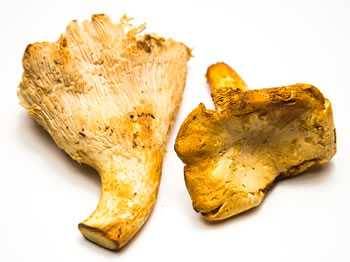
Chanterelles. These are funnel shaped with pronounced wrinkles that look like gills on the outside. They are usually orange to yellow when fresh, and when cooked get rusty brown on the outside, and the creamy insides get tan. Mild, they have a subtle nutty character and a slippery texture when cooked in butter, and they can be gritty because it is hard to get all the sand off them. Some say they have an apricot scent when fresh. Foraged, expensive.
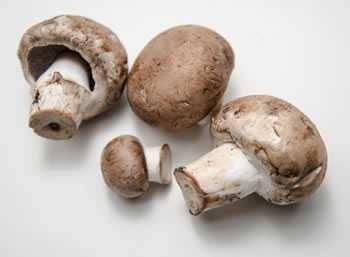
Creminis or baby bellas. These are a tan version of the cultivated common white button mushroom, and with age they are known as portobellos. They are a tiny bit richer in flavor, earthier, and meatier. The stems are usually fine eating. Cultivated, inexpensive.
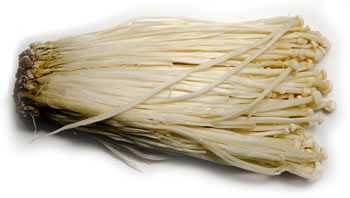
Enoki. You’ve probably seen these swimming in Chinese broths. Elegant thin golden strands with a tiny round cap, these are usually sold as bundles joined at the base. Raw they look and smell a bit like bean sprouts. Sizzled in butter or stirred into soups they wilt into limp tender spaghetti-like strands, there is a vegetal sweetness, an exotic flavor most unique among common mushrooms. I love them. Cut off the root and separate them. Cultivated, affordable.
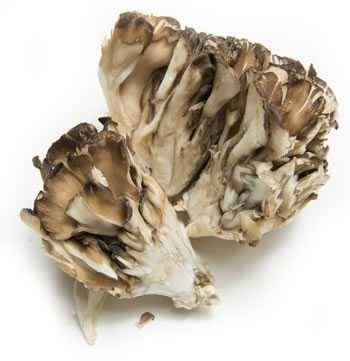
Hen of the woods or maitakes. A loose bundle of black jagged thin edges almost reminiscent of a pine come, they join at the base to form a thick milky white core of stems. Found at the base of trees and on the ground. They are slightly crunchy, with a distinctive, strong, woodsy character. Foraged and cultivated moderately expensive.
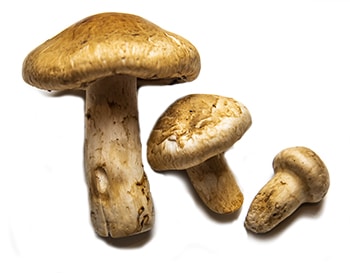
Matsutake. Revered in Japan, the “pine mushrooms” are agonizingly difficult to find in pine forests. Before their caps open to form umbrellas, the stems are disproportionately thick and long, phallic enough to make a shy Japanese girl cover her mouth and giggle. They can grow aup to 8″ across the top. They are firm and vaguely reminiscent of cinnamon. They can be found in the US, and many experts call them their favorites. Foraged. Very expensive.

Morels. The cap is a sponge like cone, often dark brown to almost black, the darker the better. They are hard to cultivate and are almost always collected from the wild in the spring, so they are expensive. Fresh morels are almost never available in stores, but they can be purchased online or in farmers markets. Dried morels can be found in many groceries or purchased online. They range from thumb sized to spice jar size. They are among the tastiest of all mushrooms, smoky, meaty, nutty, and rich. They are often breaded and fried, but they make the most amazing cream of mushroom sauces. Morels should never be eaten raw. They contain a natural substance that can give you a pretty severe stomach ache when raw, but it is destroyed by cooking.
Morels are hollow, so slice them in half lengthwise so the inside can be cleaned. Because they have a lot of pockets, you need to rinse and soak morels thoroughly with cold running water in a colander sitting in a bowl. Empty the bowl frequently and when the rinse water no longer has dirt or bugs (yes, fresh morels occasionally have bugs), dump them into the bowl and cover with fresh, cool water. Add about 1/4 teaspoon salt per cup of water. Soak for about 1 hour. Drain and pat dry gently. Mostly foraged, very expensive.

Oyster mushrooms. Fan shaped to tuba shaped, they are usually white and tan, and the gilled stems can look gray. The upper tips are fragile and break easily. The smaller the better, they have a peppery flavor and some people say they resemble oysters in taste. I don’t get oysters other than there is a resilience, like very soft rubber, that makes their texture among my favorites. Frequently served in Chinese restaurants. Cultivated, moderately priced.
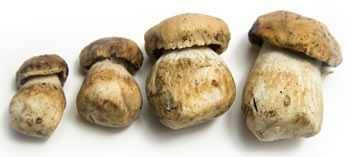
Porcini or cepes. Large Disney character toad stools with thick stems and smallish reddish brown umbrella caps. When raw they have a strong wet woodsy aroma. Easy to slice the stems have a creamy interior. When cooked in butter they are firm, with a robust sharp, perhaps slightly bitter flavor. Foraged, expensive.

Portobellos a.k.a. portabellas. These are now stocked in many groceries. The shaggy dark tan to brown tops can be up to 8″ in diameter, like the ones above, and the gills are dark brown and up to 1/4″ thick. When fresh they snap when bent. They have a robust beefy flavor, especially the gills, they are great on the grill, and can be served on a bun like a burger. They really soak up marinades. A definite step up from buttons. The stems tend to be woody and are usually removed, but if they are not tough, the are excellent for duxelles. Cultivated, inexpensive.
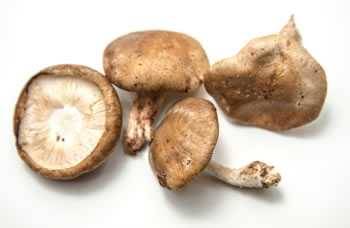
Shiitakes. Tan to brown umbrella shaped with tan gills and curving stems, the caps can grow as big as your hand, but most are 1 to 2″ across. Meaty, they are popular in Chinese cooking and have a pleasing resilient chewy texture similar to oyster mushrooms. They are subdued although some call the flavor smoky or woodsy. Occasionally the stems are woody and need to be removed. Most are cultivated in China, many in the US, and some are foraged, moderately expensive.
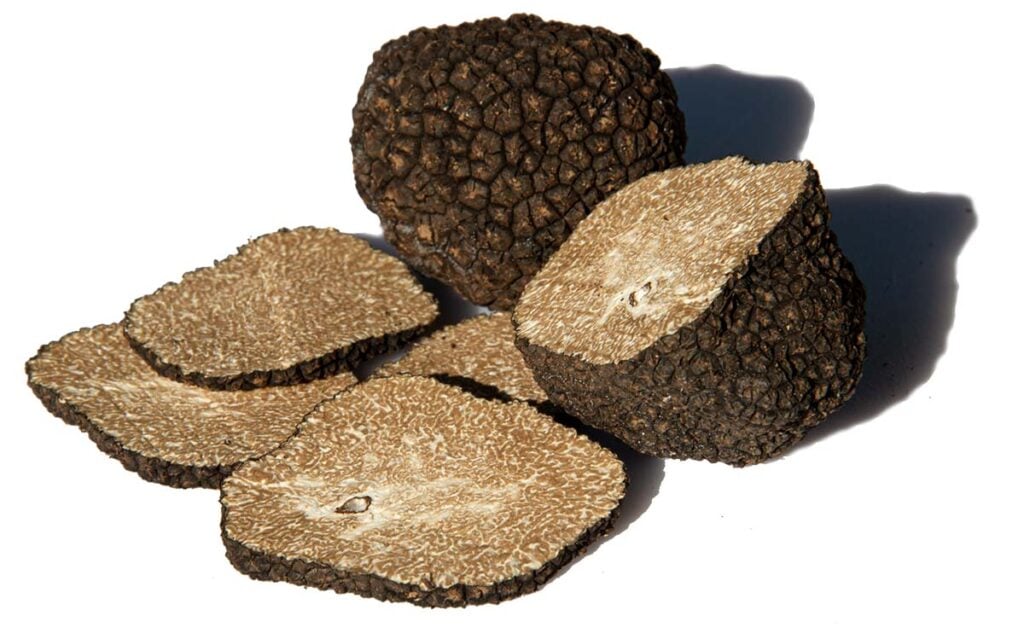
Truffles. Called by French chef Jean Anthelme Brillat-Savarin “the diamonds of the kitchen”, truffles grow underground and they are more or less round and lumpy, without a root. They are usually a bit smaller than a golf ball, although they can grow up to 6″ in diameter. They are hard to find, and almost impossible to cultivate, making them the most expensive mushroom in the world. They are not to be confused with chocolate truffles.
There are two distinct types, black (above) and white (which are really tan). Most of the world’s most desirable truffles come from Northern Italy and the Perigord region of south-central France, west of Bordeaux and east of Lyon. Next time we’re in a bar together, remind me to tell you my shaggy dog story about the time I bought half a dozen black truffles in Italy from a hotel manager (it came down like a drug deal) and how I smuggled them past US customs in an empty pickle jar filled with rice buried in my dirty laundry.
They emit a strong, distinctive musky, animal scented gas that can be overwhelming to some and an aphrodisiac to others. Foragers use specially trained dogs to hunt for them since they can smell them underground easily. Female pigs are occasionally used because they are naturally aroused by the scent, but they too often eat the prize, so they are being replaced by canines.
Unripe truffles are hard like potatoes. When they ripen they get soft and have veins on the interior. Biting into a truffle is underwhelming. Nothing special. It is the gases that create the drama, and they are released when digested, or when heated by being shaved or shredded over hot food like pasta or risotto. Chefs rarely cook with truffles, they use them as a potent garnish. The ephemeral flavors can also be extracted into oils which are used to drizzle over finished dishes, not for cooking. Sometime before you die, you need to have some shaved over my Crack & Cheese recipe.
Wild Mushrooms

Mushroom lovers know that wild mushrooms can be among the most flavorful, but they also know that you should not eat wild mushrooms unless you are absolutely positively beyond a shadow of a doubt sure that they are safe.
To taste the epitome of wild mushrooms and live to talk about it, visit Chef Chris Czarnecki at the Joel Palmer House in Dayton, OR, in the lush Willamette Valley, right in the heart of Oregon’s wine country. Practically every dish on the menu uses wild mushrooms gathered in the area, many collected by his father and the restaurant’s founder, and my old drinking buddy, Jack Czarnecki. And there are wonderful wines. This is truly a memorable meal.
Jack has written three authoritative books on the subject: Joe’s Book of Mushroom Cookery (1986), A Cook’s Book of Mushrooms: With 100 Recipes for Common and Uncommon Varieties (1995) which won a James Beard Award, and Portobello Cookbook (1997). They are available occasionally on Amazon.
Czarnecki says “Oregon white truffles (Tuber gibbosum and oregonense) are similar to Italian white truffles (Tuber Magnatum Pico) in that they share a garlicky-cabbage aroma. They are not as intense as the Italian truffles, however. But what they lack in intensity they make up for in aroma complexity. The Oregon white truffle oil has floral and herbal overtones while the Italian truffles are stronger and exhibit overtones of musk, garlic, and cabbage. This has been demonstrated in side-by-side comparisons of their volatile organic compounds (gases). Oregon white truffles compared to Italian white truffles is like the difference between Pinot noir and Cabernet sauvignon, respectively. Oregon black truffles (Leucangium carthusianum), on the other hand, are very different from French Perigord truffles (Tuber Melanosporum). The Perigord black truffle has a pleasant odor of earth, must, and iodine. The Oregon black truffle has an odor of mango, chocolate, and earth. Those sweet odors, especially when made into oil, are intriguing ingredients for desserts.” A majority of black truffles are now cultivated while almost all white truffles are wild, they are all very expensive with whites slightly more dear.
Finally, a word about “truffle” oil. Jack has stepped out of the kitchen and now runs Oregon White Truffle Oil. He sells the real deal, premium olive oil scented with real truffles. Almost all “truffle oil” is made by adding chemicals that smell like truffles. Read the label. If it says “truffles and oil” it’s the real deal. If it says Oil and truffle aroma” it is ersatz. Jack’s is made with real truffles.



High quality websites are expensive to run. If you help us, we’ll pay you back bigtime with an ad-free experience and a lot of freebies!
Millions come to AmazingRibs.com every month for high quality tested recipes, tips on technique, science, mythbusting, product reviews, and inspiration. But it is expensive to run a website with more than 2,000 pages and we don’t have a big corporate partner to subsidize us.
Our most important source of sustenance is people who join our Pitmaster Club. But please don’t think of it as a donation. Members get MANY great benefits. We block all third-party ads, we give members free ebooks, magazines, interviews, webinars, more recipes, a monthly sweepstakes with prizes worth up to $2,000, discounts on products, and best of all a community of like-minded cooks free of flame wars. Click below to see all the benefits, take a free 30 day trial, and help keep this site alive.
Post comments and questions below
1) Please try the search box at the top of every page before you ask for help.
2) Try to post your question to the appropriate page.
3) Tell us everything we need to know to help such as the type of cooker and thermometer. Dial thermometers are often off by as much as 50°F so if you are not using a good digital thermometer we probably can’t help you with time and temp questions. Please read this article about thermometers.
4) If you are a member of the Pitmaster Club, your comments login is probably different.
5) Posts with links in them may not appear immediately.
Moderators